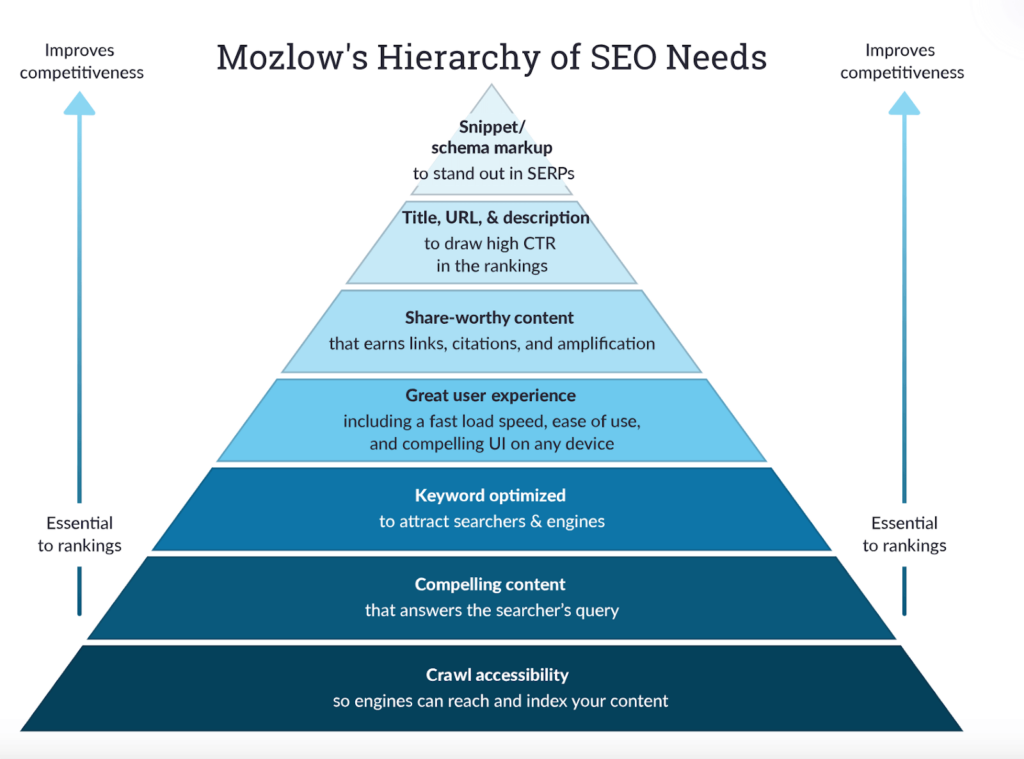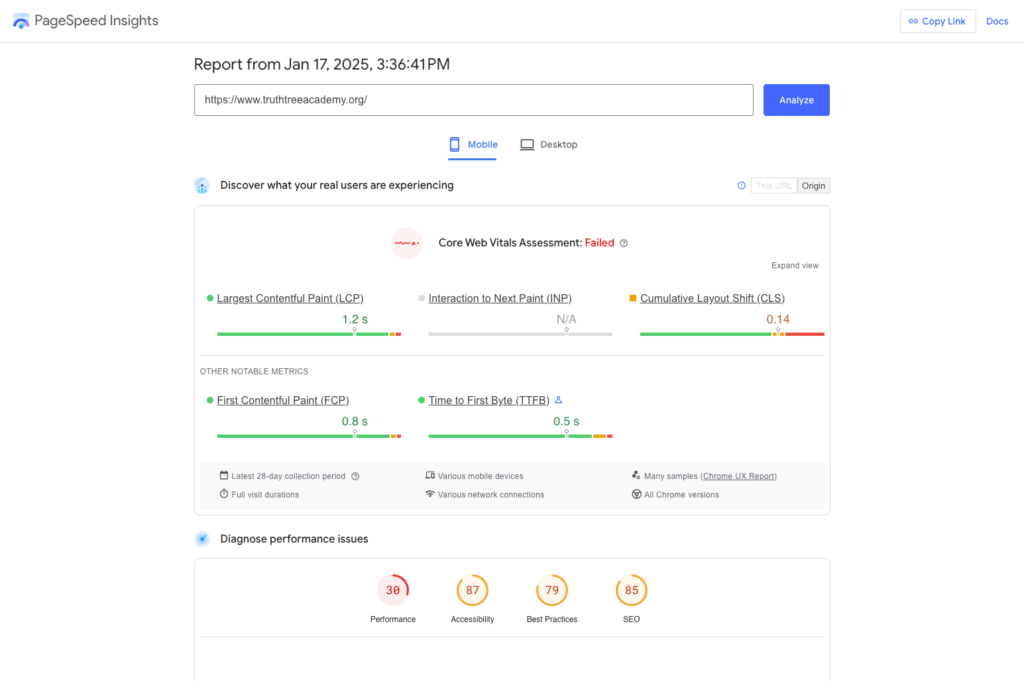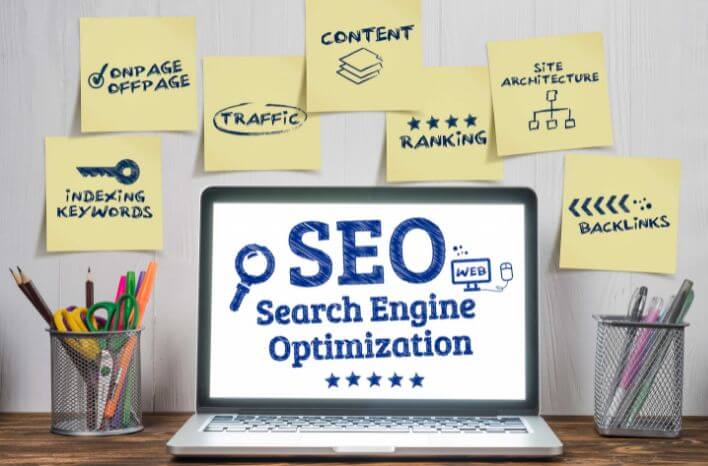By Maggie Twaroski, Truth Tree Contributor
The start of a new year is the perfect time to lay the groundwork for an impactful semester of high-performing content that enhances your school search engine optimization (SEO) strategy. As your team steps into the new calendar year with fresh energy, it’s the ideal moment to refine your school’s SEO efforts, set clear priorities, and elevate your school’s digital presence to connect with prospective families more effectively.
Strengthening your school search engine optimization at the start of the year ensures your content ranks well and continues to reach the right audience for months to come.
Here are five things to focus on in the coming weeks to optimize your current content and set the stage for stronger SEO this year:
- Crawlability
- Loading speed
- Links
- Page structure
- Image optimization
Crawlability
Search engines crawl the internet when they look for pages to store in their indexes and display in search results. When search engines crawl your website, they’re looking for signs that tell them what each web page, image and video is about. Then, they work that information into the search engine’s algorithm to provide rankings.
When we talk about crawlability, we’re referring to the ease at which search engines can crawl your website. Crawlability is a key prerequisite to all other SEO tactics, because it ensures that search engines are able to effectively find your content. This SEO hierarchy by Moz illustrates the foundational importance of crawlability, placing it even before content quality and keyword optimization.

Your site speed, linking procedures, page structure, and image optimization all influence crawlability, so make sure to identify any barriers in these areas that might keep search engines away (more on that later).
Here are three more quick fixes you can do to instantly improve your site’s crawlability:
Fix broken links: It’s a good idea to periodically look through your web pages to find and replace any broken links, as these are big red flags for search engines trying to crawl your site.
Optimize pages for mobile devices: Sixty three percent of online searches take place on mobile devices, which means a mobile-friendly website is an absolute must for maintaining crawlability. Without adaptable web pages, it will be much harder for search engines to crawl and index your website.
Update meta descriptions: Search engines use meta descriptions to help deliver relevant results to users. Improve your SEO by rewriting any dull meta descriptions with more relevant keywords, enticing language, or by changing the length to make them either more detailed or concise.
Page load speed
It’s no secret that online users have extremely short attention spans–three seconds to be exact. If your web pages take longer than three seconds to load, that’s a big red flag for search engines trying to crawl your site. Keep in mind that loading speed doesn’t just refer to the site it takes for a page to load. It also refers to the loading speed of various elements on that page, whether it’s an image, video, form submission, or button clicks. To make sure all pages and elements are running quickly, conduct a page speed audit to get instant insights on loading times.

Once you know how your pages pass the speed test, you can make strategic adjustments. Here are some quick fixes for improving page loading times:
Compress images: Large images and videos can easily disrupt loading times. If you find some of your media loads too slowly, simply compress them to a smaller size for a better user experience.
Minimize redirect chains: A redirect chain occurs when an initial URL request goes through numerous URL changes to arrive at the final destination. Redirect chains that are too long can hurt your loading time and user experience, so it’s important to minimize these as much as possible. Tools like ScreamingFrog can help resolve chain issues.
Links
Three types of links can majorly boost your SEO–internal, inbound, and outbound. Weaving these into your website content increases the visibility of your pages, making it easier for searching engines to crawl, index, and rank your website. Plus, links provide value and support for your visitors. Here’s what you need to know about SEO links:
Internal links:
- Come from other pages on your website
- Signal that you have a robust digital library to draw internal links from
- Can be used on your blog or any other page where internal references are useful
Inbound links:
- Come from other websites that link to yours
- Signal that your school brand is respected by other high-quality websites
- Can be earned through guest posting, resource pages, local link building, and other tactics
Outbound links:
- Direct readers to other helpful, reputable websites
- Signal that you want to provide value to your readers by sourcing other high-quality sites
- Common outbound links may be to news articles, associations, accreditation entities, or scholarship providers
Spend the next few weeks combing through your website and updating pages with internal and external links, making sure they’re relevant to the page topic and provide value to readers. Then, start doubling down on your current inbound link strategy, or try some new link-building tactics that can help get your website circulating on other reputable websites.
Page structure
You may have some of the most well-written, compelling content out there, but if it’s dumped onto the page in a big text block, no one will read it. The way we structure pages is just as important as the content itself because it’s the leading factor in enticing people to read.
A page that is visually appealing will significantly improve the user experience, which ultimately improves your SEO. Plus, these elements also help search engines understand what your page topic is about, helping them relate your page to certain search queries.
Look through your existing content pages and spruce them up with some of these structural elements:
- More or better visuals
- Headings and subheadings
- Bullet points
- White space
Image optimization
When search engines crawl your content, the images you have on your page can be just as informative as the written content itself. When you optimize images with descriptive file names and alt text, you’re providing additional signals to search engines on what your content is about, and how it relates to specific search queries.
Make sure all of your image file names start with a description and end with your school name and city. Let’s take a picture of your school’s lacrosse team as an example:
✅ Good: Lacrosse-team-moundsview-academy-pa.jpg
❌ Bad: LAX-2024-PA.jpg
While the latter indicates an image of lacrosse, it doesn’t incorporate any of the relevant keywords in common web searches. Search engines prefer the former, because it incorporates descriptive keywords that relate to a specific query like “private schools in PA with lacrosse.”
Adding alt text to images is another big SEO boost because it’s another description that helps search engines crawl, index, and rank your content. Alt text also makes images more accessible to your website visitors with visual handicaps. Whether you’re adding alt text to new images or updating old ones, make sure it’s concise and descriptive.
Shore up your 2025 SEO plans
As SEO continues to evolve, it’s important for school marketers to stay sharp and freshen up content to align with current SEO best practices. Start the new year off strong by spending the next few weeks improving your website crawlability, loading speed, links, page structure, and image optimization. With a few quick fixes, you’ll have the framework you need to meet next year’s SEO goals.
Does your school need more SEO help than these 5 tips?
Strategic SEO work can land your school in the top placements of search engine results (think Google search results), and it can be a game-changer for prospective families in their initial searches.
What would it look like to have an SEO specialist guiding your team?
